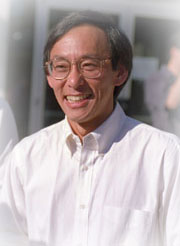|
|
|
|
GS: So that's an unheard of density.
SC: At that time it was unheard of density but you couldn't cool atoms like that --
it simply didn't exist. Now you have a thousand atoms in a trap that 10 to the
minus 6 by 10 to the minus 6 so you had 10 to the 9 atoms in a cubic
centimeter. 10 to the 9 in a cubic centimeter is really not that high a density.
Solids are much much higher than that. But for cold atom tehcnology that was an
enormous density at the time. It's now routinely achieved by other methods.

GS: It's been a number of years since you've done this.
SC: A lot of water -- a decade, no two decades. Getting old.
GS: At that time you started thinking Nobel Prize?
SC: No, absolutely not.
GS: When did you think you had a good chance of getting a Nobel? Or do physicists think like that?
SC: A good chance is an exaggeration. A chance was occurring. So we were elated
that we finally got this dream to work. And then something strange happened.
It was about that time that one started really seriously thinking. What are you
going to do with these. There were a few applications that people knew about.
If you could get the atoms very cold -- not trapped, just cold -- you could make
a better atomic clocks. Beyond that, and maybe you could Bose-condense. There
was loose talk. I remember even during a New York Times interview in
1985 when the trapping was finally accomplished, well maybe you can
Bose-condense that. But if you looked seriously at that it looked very far
away. But what the scientific community had been doing at the time was
thinking, well it might be possible, but not focusing on what you could do with
it because it wasn't at hand. That's typical in many cases where you say, Oh
well, it might work, it might not. Because a lot of things don't work, so you
don't really give serious thought to what you can do with it.
After we trapped them and cooled them and found that things were working better
than anticipated, this tended to liberate people's imaginations in a big way,
mine and others as well. So as a community we weren't really focused. There's
a huge list of things you could do once you got this to happen. It was more an
intuitive feeling that it might be good for something. Analogy being, Well we
can push around electrons and protons, electromagnetic forces, we can exert
influences on them, we can hold onto them. Well this might be good for
something too. What it would be best for, who knows.
It was very much the same with the laser. The initial reason for inventing a
laser was for scientific purposes just to extend what was the counterpart in
microwaves, namely the maser, into the optical range. If you ask the inventor
of the laser -- and I know them very well. One was Art Shallot who was in the
office next to mine and the other is a friend of mine Charlie Towns in Berkeley.
You'd ask Art Shallot, what were you thinking of in the initial days when you
were inventing the laser? What were the applications? The answer would be, We
don't really know. In fact with the laser, it was so radical a departure that
there used to be a joke -- it was an invention looking for an application.
GS: There are plenty now.
SC: But nobody in those early days in the Fifties and early Sixties thought it would
be used for printing, communications. Well maybe there's one or two who might
have thought communications, but not in the way imagined with optical fibers.
For computer connections, for eye surgery, etc... What happened with atoms, the
atomic clock part came to fruition. In fact, one of the first experiments I did
when I came to Stanford was to create what was called an atomic fountain that
could make more precise atomic clocks. Within a decade it became the time
standard of the world. That was something I was aware of since I was a post
doc. If you could make a fountain of atoms, you could make a better clock.
GS: How does that work?
SC: It's based on the Heisenberg Uncertainty Principle which tells you there are
going to certain limitations in a measurement. It says the following: the
product of the time you take to make a quantum measurement -- and we'll call
that delta-T -- times the spread in energy that you must see when you make this
quantum measurement -- we'll call that delta -E -- the product of those two have
to be greater than or equal to a fundamental constant of nature called Planck's
Constant. If you want to make a better measurement, you want a smaller delta-E,
a smaller uncertainy in the energy. You have to spend a longer time making the
quantum measurement. By that we mean in particular for this type of experiment,
it's the time that it takes to make the transition from one atomic state to
another atomic state. So quantum measurement time doesn't mean the time it
takes to build the apparatus or the time it takes for the observer to log the
data into the computer notebook, none of that stuff. It's really the
interaction of the quantum that it takes the atom, with the electromagnetic
radiation, how long does it actually take for a single atom to make a transition
from one state to another state?
If you work with atoms in normal room
temperature, they're moving at the speeds of supersonic jet planes. They whiz
by your electromagnetic fields in times on the scale of one millionth of a
second. So the time you have to make the transition is so short, the spread in
energy you're gonna necessarily have is reasonabnly large. And then you have
this spread of probability of exciting the atom and you try to find the center
of that the best you can but you're still going to be limited.
Then in the 1950s a professor then at Columbia University named Norman Ramsey
figured out a way to get around this. He said, Suppose you have these atoms
that are going very fast and you start the measurement in one region where the
atom whizzes through a microwave cavity and it goes another meter or so into
another cavity and in the second cavity you complete the excitation from the
ground to the excited state, there the quantum measurement time becomes not the
time it takes to go through the single cavity which is a millionth of a second,
but it becomes the time it takes to transit from one cavity to another. Now
this sounds all very technical and everything but it led to a profound change in
the way we make measurements and it gave birth to atomic clocks.
GS: So atomic clocks are actually based on averages.
SC: Of course they're based on averages.
GS: The average of atomic behavior.
SC: Yes and no. Atomic clocks are really based on the energy levels of atoms.
Because an atom isolated in space has these very well defined energy levels and
you with your man-made gizmo have all the things that are problems for man-made
things. They're not stable, they drift, they do this, they do that. And so
what an atomic clock basically is, it's a microwave radio frequency or
microwave, in this case microwave generator, that generates electromagnetic
signals, and imagine you've got your hand on the dial, and you're dialing this
continually resetting it so that it stays in resonance with isolated atoms. And
then you read out what that frequency is. So you slave the microwave generator
to the energy level differences of an atom, but then you look at many atoms.
They all whiz by, as each one whizzes by, you continually readjust this dial,
but each atom is identical. So that's the basic atomic clock.
Nature gives you these pristine atoms which have well-defined energy levels.
They're all exactly the same, atoms in Russia are exactly the same as atoms in
the United States. And you just adjust your manmade dial to this energy level.
So that's the basic idea of an atomic clock. Then the idea is how do you make
it real precise. And then it goes to the uncertainly principle that says you
want to spend a lot of time adjusting your dial.
GS: In order to do that you need to make it have a very low energy level.
SC: Not in energy level, you have to make it move very slowly so you have plenty of
time to make the transition from one energy level to the other energy level. If
you only have a millionth of a second to make that transition...
GS: ...you want it to have very little temperature?
SC: Low temperature means slow velocity means it lingers and the measurement [is improved].
GS: When was this innovatioin in atomic clocks implemented?
SC: It was this series of experiments. We had made the first atomic fountain experiment here at Stanford,. And then in France where they work for BIPM.
It's the equivalent of the Bureau of Standards there, in collaboration with
another laser cooler Bill Phillips, who was cooler Miller Fries. They made a
similar fountain but in cesium, the atom that was the time standard. We did it
in sodium because we happened to be working with laser cooling and trapping in
sodium. But we followed with a more serious cesium clock where for the first
time we showed that this thing could exceed the short-term stability of the
existing clocks on the market.
GS: What date was that?
SC: The first atomic fountain I believe was... I don't want to say something wrong
so let me just look at my list of publications... 1989 was the first atomic
fountain.
GS: What was the order of magnitude of improvement in precision?
SC: It was in steps and a toggle between two groups. In 1989 we demonstrated proof
of principle. And by 1995, '96 the precision and the accuracy -- and this was
again done by this French group -- then exceeded the time standards, really the
best time standards. They were comparable or better than the absolute best time
standard. So that's '89 to '96 then.
PAGE 4
Page 1 |
2 |
3 |
4 |
5 |
6
|
|
|
|
|
“Nature gives you these pristine atoms which have well-defined energy levels.
They're all exactly the same, atoms in Russia are exactly the same as atoms in
the United States.”
|
CONTACT US
|
ADVERTISING INFO
© 1996-2013 Asian Media Group Inc
No part of the contents of this site may be reproduced without prior written permission.
|


